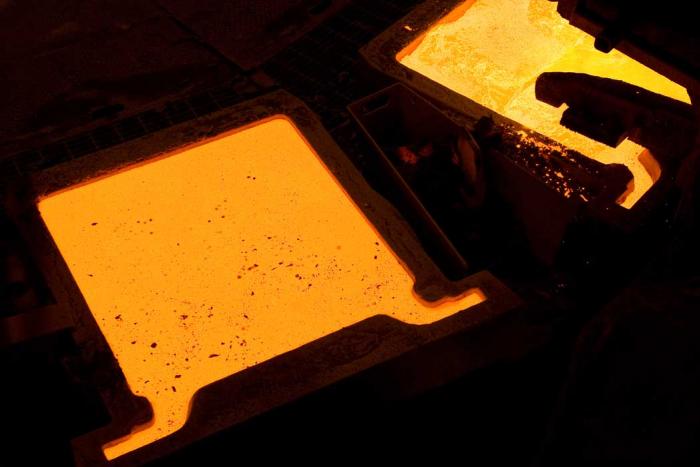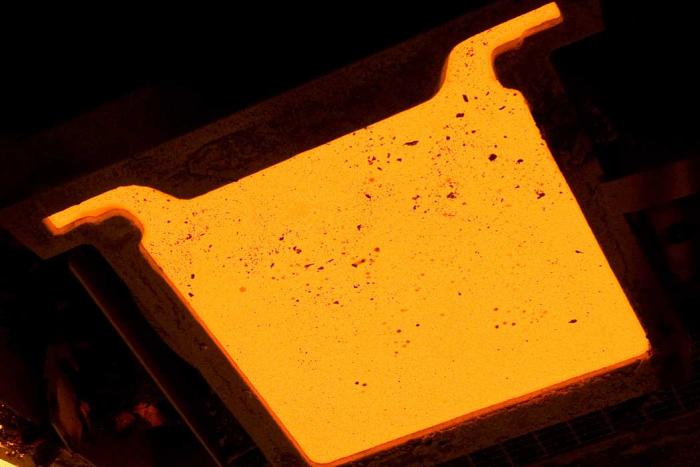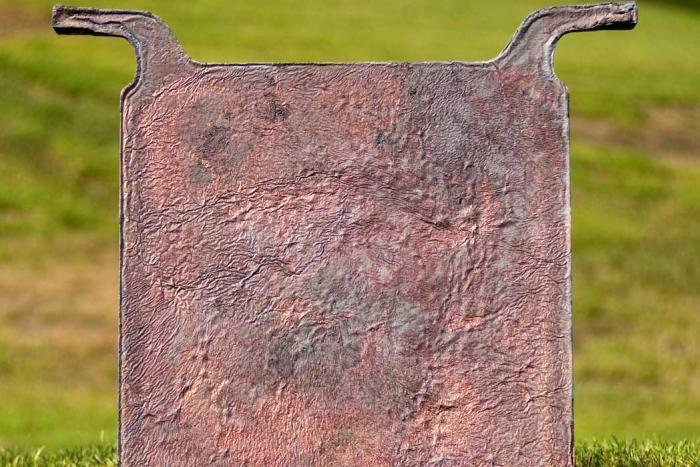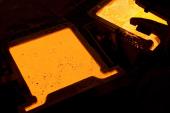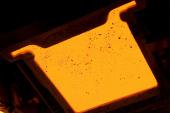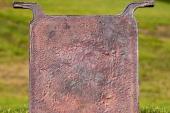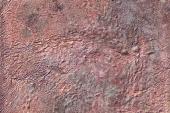Copper Anode
Organization: Neighbours Regional Association of Rouyn-Noranda
Coordinates: www.neighbours-rouyn-noranda.ca
Address: 139, av Murdoch Rouyn-Noranda, QC J9X 1C9
Region: Abitibi-Témiscamingue
Contact: Sharleen Sullivan, 819-762-0882, neighbours(a)cablevision.qc.ca
Description: Copper anode from the Noranda Mines in Rouyn-Noranda, Quebec
Year made: 2008
Made by:
Materials/Medium: Copper
Colours: Copper
Provenance: Rouyn-Noranda, Quebec
Size: 116.8 cm x 104.1 cm x 5 cm
Photos: (1-2) Cyclopes. Courtesy Xtrata Copper Canada, fonderie Horne; (3-4) Courtesy
Centre d'Archives de l'Abitibi-Témiscamingue et du Nord du Quebec
Copper Anode
Jessica van Horssen
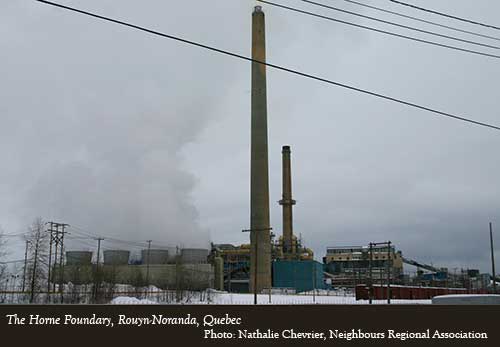
This copper anode has been processed from the copper found in the mines at Rouyn-Noranda Abitibi-Témiscamingue in the Abitibi-Témiscamingue region of Quebec.
Copper in this region is found in thin veins alongside—and often intertwined with—deposits of gold, silver, and zinc. Nineteenth century geological surveys only discovered small copper deposits in the region, and the dense forest and difficult-to-navigate waterways of the area meant that this resource went largely undiscovered and undeveloped until the 20th century (Geological Survey of Canada).
Copper has been used around the world for over 10,000 years, as it is a versatile metal that can be molded into a variety of shapes for both decorative and utilitarian purposes. The fact that it conducts heat and electricity extremely well made it an essential metal in the rapidly industrializing western world, causing copper to be in high demand for over a century. To develop marketable copper in this region requires a complex mining, smelting, and processing system that melts the copper free from its surrounding rock and molds it into marketable, useable forms.
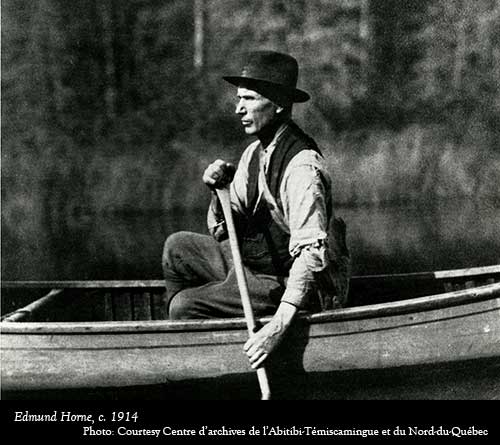
In 1911, Nova Scotian prospector Edmund Horne began exploring the metal and mineral deposits of northwest Quebec. After several visits, in 1920 he staked a claim on the massive copper deposits of the region. The Horne Mine opened in 1922, and a large, diverse group of workers quickly moved to the newly created community of Rouyn. Horne sold his claim to Noranda Mines, an Anglophone company run by James Y. Murdoch that operated mines throughout Quebec and around the world.
Noranda created a classic resource community in Rouyn, with homes, infrastructure, and services often owned and operated by the company. The managers and engineers at the mine were largely Anglophone because of the advantages and opportunities this linguistic group traditionally had in the province. The proximity of the mine to northern Ontario, which had similar mining operations, further solidified the dominance of Anglophones in top management roles. In the early years of the mine, Noranda almost exclusively employed new immigrant workers rather than those from the large French Canadian majority in the province. Polish, German, Italian, Yugoslavian, and Ukrainian workers created a great cultural diversity within the community, which was added to after a particularly lengthy strike in 1934 led Noranda to begin employing French Canadian workers as well (Gaudreau).
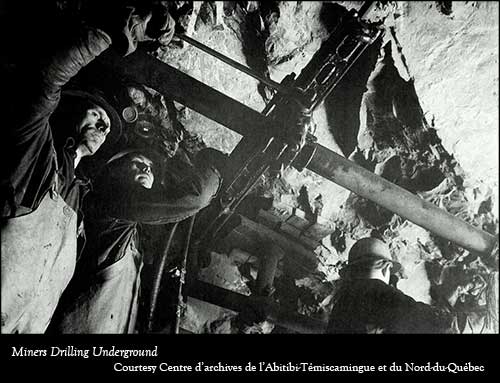

Whether they worked in the mine or in a local grocery store, the entire population of Rouyn was dependent on Noranda and the international demand for copper. This reliance, as well as the exclusively Anglophone management of the mine, quickly became a gauge that showed how Quebec was changing in the mid-20th century. Relations between the minority Anglophone managing class and the majority Francophone working class at the mine and throughout the community had become increasingly strained, and Noranda became a symbol of all that was wrong with how businesses were run in Quebec. As head of the ministère des Richesses naturelles in the 1960s, René Lévesque accused Noranda of being a colonizing force in Quebec, and helped the copper miners of Rouyn unionize to become stronger within the industry, community, and province (Guentzel).
Mining and processing copper creates a great deal of environmental contamination, and the copper communities in northwest Quebec have made a tremendous effort towards cleaning up this pollution and creating healthy living spaces for humans and wildlife alike. Mined in Quebec for almost a century, and in continued demand around the world, copper acts as a tool for measuring the cultural and political changes that have occurred within the province throughout its history.
Sources
“Geological Survey of Canada, Report of Progress for 1871-1872,” (Montreal: Dawson Brothers, 1872).
Guy Gaudreau, “Les causes d'une participation a la grève: grèvistes et non-grèvistes de la Noranda Mines Ltd, juin 1934,” Labour/Le Travail, Fall 1999.
R.P. Guentzel, "Rapprocher les lieux du pouvoir": The Quebec Labour Movement and Quebec Sovereigntism, 1960-2000. Labour, (46). 2000.
To Learn More
Mining, www.thecanadianencyclopedia.com
Abitibi-Témiscamingue Heritage Trail, http://www.quebecheritageweb.com/attraction/abitibi-temiscamingue
Musée Minéralogique de l'Abitibi-Témiscamingue, www.museemalartic.qc.ca
Author
Jessica van Horssen is an Assistant Professor in the History Department at York University. She has a forthcoming monograph on the history of the town of Asbestos, Quebec with the University of British Columbia Press entitled, Asbestos: Environmental Change, Contamination, and Collapse. She has also written a graphic novel about the town of Asbestos, which can be found here: http://megaprojects.uwo.ca/asbestos/


